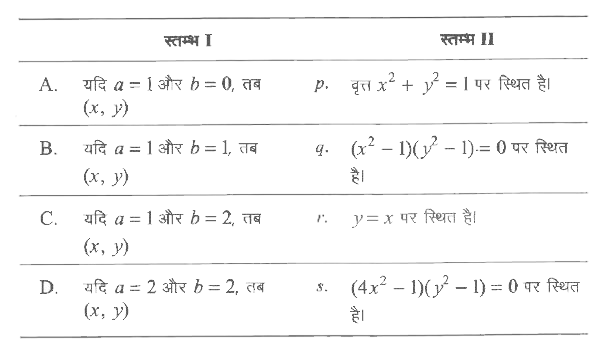कोणों A=2tan−1(2√2−1) और B=3sin−1(13)+sin−1(35) में बड़ा कोण …………… है।
कोण A
कोण B
कोण A = कोण B
इनमें से कोई नहीं
The correct Answer is:A
Step by step video, text & image solution for कोणों A=2tan^(-1)(2 sqrt(2)-1) और B=3sin^(-1)((1)/(3))+sin^(-1)((3)/(5)) में बड़ा कोण …………… है। by Maths experts to help you in doubts & scoring excellent marks in Class 12 exams.
Updated on:21/07/2023Topper's Solved these Questions
- प्रतिलोम वृत्तीय फलन BOOK - JEE Main & Advanced (Hindi Medium)CHAPTER - प्रतिलोम वृत्तीय फलन EXERCISE - मैट्रिक्स-सुमेल प्रकार
1 Videos
- प्रतिलोम वृत्तीय फलन BOOK - JEE Main & Advanced (Hindi Medium)CHAPTER - प्रतिलोम वृत्तीय फलन EXERCISE - विश्लेषणात्मक प्रश्न
2 Videos
- प्रतिलोम वृत्तीय फलन BOOK - JEE Main & Advanced (Hindi Medium)CHAPTER - प्रतिलोम वृत्तीय फलन EXERCISE - बहुविकल्पीय प्रश्न II (एक से अधिक विकल्प सही है)
1 Videos
- परवलयBOOK - JEE Main & Advanced (Hindi Medium)CHAPTER - परवलयEXERCISE - एकल पूर्णांक प्रश्न
5 Videos
- प्रायिकताBOOK - JEE Main & Advanced (Hindi Medium)CHAPTER - प्रायिकताEXERCISE - एकल पूर्णांक प्रश्न
2 Videos
Similar Questions
माना (x, y) इस प्रकार है कि
sin−1(ax)+cos−1(y)+cos−1(bxy)=π2
स्तम्भ I में दिए गए प्रतिबंधों का स्तम्भ II में दिए गए मानों के साथ सुमेल कराएँ।

View Solutionमूल्यांकन कीजिए -
cos(2cos−1x+sin−1x),x=15, जहाँ 0≤cos−1x≤π और −π2≤sin−1x≤π2.
View Solutionयदि α=3sin−1(611) और β=3cos−1(49) , जहाँ प्रतिलोम त्रिकोणमितीय फलन केवल मुख्य मान ही लेते हैं, तब सही कथन है (हैं) :
View Solutiony2=8x एक परवलय है। मान लीजिए एक त्रिभुज का क्षेत्रफल है जो नाभिलम्ब जीवा के सिरों और परवलय के बिन्दु P(12,2) द्वारा निर्मित है और Δ2 उस त्रिभुज का क्षेत्रफल है, जो बिन्दु P पर और नाभिलम्ब जीवा के सिरों पर खींची गई स्पर्शियों द्वारा बना है। तब Δ1Δ2 है।
View Solutionतीन स्वतंत्र घटनाओं E1,E2 तथा E3 में से केवल E1 के घटने की प्रायिकता α है केवल E2 के घटने की प्रायिकता β है तथा केवल E3 के घटने की प्रायिकता γ है। माना कि घटनाओं E1,E2 या E3 में से किसी के भी न घटने की प्रायिकता p, समीकरणों (α−2β)p=αβ तथा (β−3γ)p=2βγ को संतुष्ट करती है। सभी प्रायिकताएं अंतराल (0,1) में स्थित मानी जाती है तब E1के घटने की प्रायिकताE3के घटने की प्रायिकता=
View SolutionIf 3sin−1(2x1+x2)−4cos−1(1−x21+x2)+2tan−1(2x1−x2)=π3, then x is equal to (A) 1√3 (B) −1√3 (C) √3 (D) - √34
View SolutionThe greater of the two angles A=2tan−1(2√2−1) and B=3sin−1(13)+sin−1(35)is ____.
View Solution2tan ^ (- 1) ((1) / (2)) + sin ^ (- 1) ((3) / (5)) =
View SolutionIf A=9tan^(-1)(sqrt(2)-1) and B=3sin^(-1)((1)/(3))+sin^(-1)((3)/(5)) then
View SolutionIf alpha,beta and gamma are the three angles with alpha=2tan^(-1)(sqrt(2)-1);beta=3sin^(-1)((1)/(sqrt(2)))+sin^(-1)(-(1)/(2)) and gamma=cos^(-1)((1)/(3)), then
View SolutionIf alpha,beta and gamma are the three angles with alpha=2tan^(-1)(sqrt(2)-1);beta=3sin^(-1)((1)/(sqrt(2)))+sin^(-1)(-(1)/(2)) and gamma=cos^(-1)((1)/(3)), then
View Solutionsin−1(1√2)−3sin−1(√32)=
View SolutionThe greater of the two angles A=2tan−1(2√2−1) and B=3sin−1(13)+sin−1(35)is ____.
View Solution2tan−1(1/2)+sin−1(3/5)=
View SolutionIf A=2tan−1(2√2−1)andB=3sin−1(1/3)+sin−1(3/5) then
View Solution
